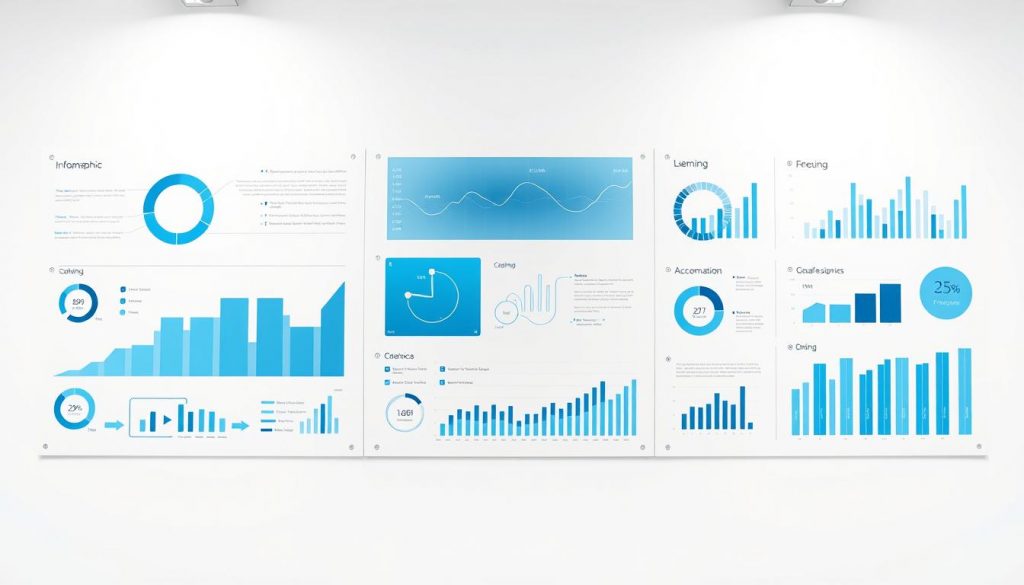Can a small business stretch a modest budget and still win meaningful customers? This guide argues it can, by focusing on smart, high-ROI moves that build brand awareness and drive action.
The plan shows how a firm can use local SEO, a well-optimised Google Business Profile and consistent social media activity to lift visibility without large spend. It explains how to use simple content formats—infographics, short videos and webinars—that save production costs while boosting engagement.
Readers will see how to audit past data, pick a few reliable channels and map activity to the sales funnel so each tactic serves a clear purpose. The emphasis is on practical tests, promo credits and partnerships that increase reach and help the website convert visitors into leads.
Small budgets need clear focus. With priority actions and measurement embedded, the business can scale what works and stop what does not.
Key Takeaways
- Prioritise high-ROI tactics that build brand awareness and drive conversions.
- Use free local SEO and an optimised Google Business Profile to boost local visibility.
- Leverage low-cost content formats and social media for steady audience growth.
- Audit data, focus on proven channels and run small tests for new ideas.
- Embed measurement so the business can prove impact and reinvest wisely.
Why a tight-budget digital marketing plan matters right now
Inflation and changing platform economics mean marketing teams must be nimble and pragmatic with every pound.
Present-day pressures: Rising inflation forced many firms to cut spend in 2023, and yet most expect to lift investment again by late 2024. Deloitte notes nearly half of marketers trimmed budgets, while social spend is forecast to rise and mobile will grab more of marketing costs over the coming years.
Present-day pressures: inflation, shifting spend, and agility
Teams should adopt agile budgeting so they can move money quickly as platforms and audience habits shift.
Ringfencing a small testing fund keeps companies learning without overspending on one channel.
Setting realistic expectations for ROI on limited funds
Not all activity will show instant returns. Awareness work often helps later-stage campaigns. That means assessing results by funnel stage, not only last-click performance.
- Prioritise low-cost, high-learning tactics that protect reach and improve decision-making.
- Monitor simple metrics with a lightweight dashboard so performance is visible even on a small budget.
- Account for industry and audience differences when choosing strategies; one approach rarely fits every sector.
How to Create an Effective Digital Marketing Strategy on a Tight Budget
Clarity on targets makes it far easier for small teams to focus scarce time and cash. With explicit goals, businesses decide which marketing actions deserve most attention and which can be paused.
Define SMART goals aligned to business objectives
Set a small number of SMART goals that map directly to revenue or lead targets. This keeps the team focused and helps judge whether any spend delivers clear results.
Audit past results to double down on what works
Run a rapid 6–12 month audit. Identify strategies, creatives and offers that drove the best traffic and leads.
Move money toward those proven areas and keep a concise log of data and performance.
Adopt the 70-20-10 allocation rule
Allocate 70% of the marketing budget to steady performers, 20% to promising new approaches and 10% to experiments with clear hypotheses.
Work within constraints: people, tools, and campaign costs
Itemise people time, tool licences and campaign cost before planning. Use simple spreadsheets or lightweight tools to track spend and results weekly.
Plan pause thresholds for CPA or CAC so limited money is protected while the team moves quickly.
Map your strategy to the sales funnel to avoid wasted spend
Linking each tactic to a funnel stage helps teams spend where it actually moves customers forward. This reduces overlap and makes every action accountable.
Awareness
Use low-cost reach such as ad promo credits and short videos with a single message. Drive traffic to clean landing pages and pick channels that match audience habits.
Interest
Publish targeted posts and practical content that answer likely questions. Follow up with a brief outreach email that invites deeper engagement from potential customers.
Decision
Build trust with webinars, tutorials and clear testimonials. These proof points lower friction and make predictable sales more likely for the customer.
Action
Simplify the final step: offer discounts, freebies or a single clear call to action. Make the next move obvious so customers convert with minimal hesitation.
- Track stage metrics: view-through at Awareness, engaged sessions at Interest, attendance at Decision and conversion rate at Action.
- Choose an attribution model that fits the buying cycle; position-based or time decay often shows value across multiple touchpoints.
- Review monthly and shift spend from weak steps to those that reliably feed the sales pipeline.
Free and fast wins to boost brand awareness and traffic
Simple platform changes unlock local search and social reach almost overnight. Local firms gain immediate visibility with a few focused moves that cost nothing but time.
Claim and optimise the Google Business Profile. Verify the listing, add accurate categories, services and photos, post updates and complete Q&A. This captures high-intent local searches and drives clicks back to the website with minimal effort.
Post and engage on social media
Establish a steady rhythm of short, useful posts and replies. Use tags and a blend of trending, niche and location hashtags so posts surface to local people and sector audiences.
Leverage user-generated content and employee advocacy
Encourage customers to tag the business and share experiences. Repost content with permission for authentic social proof and lower production costs.
- Encourage staff to share company updates on LinkedIn to multiply reach.
- Add UTM tags to profile links and posts to track which platforms drive enquiries.
- Keep a consistent voice and respond quickly to comments to build trust.
For more low-cost ideas, see this free and low-budget marketing ideas.
Low-effort, high-impact tactics that compound over time
Consistent, simple tactics quietly lift visibility and convert curious visitors.
Local work often delivers the biggest early wins for small teams. Start with on-page local SEO by adding clear location terms in title tags, H1s and body copy. Keep NAP (name, address, phone) exact across major directories so search engines and customers see the same details.
Create basic location pages for towns and neighbourhoods served. Each page should describe services, coverage and include at least one local testimonial. These pages help the website rank for “near me” and town searches without large spend.
Local SEO basics: on-page keywords, directories, and location pages
Ensure directory listings match and use consistent categories. Small, free fixes here compound over months as citations build trust.
Email marketing that nurtures existing customers and new sign-ups
Launch email marketing with an opt-in on priority pages and a short welcome sequence that gives value first. Use a free tool such as Mailchimp and test subject lines, send times and layouts to lift engagement.
Content marketing and blogging that answer real customer questions
Publish concise blog posts that solve actual queries heard on calls or emails. Two short posts a month creates a library that supports SEO and sales over time. Repurpose key points into social snippets and emails to get more mileage from each piece of content.
| Action | Effort | Benefit |
|---|---|---|
| Update title tags & H1s with location | Low | Better local rankings |
| Publish location pages | Medium | More “near me” traffic |
| Welcome email sequence | Low | Higher engagement from new sign-ups |
| Two short blog posts monthly | Low | Improved visibility and leads |
Track open and click rates alongside enquiries so work is judged by pipeline impact. Small tests and steady rhythm produce measurable results for marketing teams with limited time and cash.
Stretch your marketing budget with smart content formats
Well-designed, repurposable content can turn one idea into many audience touchpoints without big fees.
Infographics are highly shareable and cost-effective. Use tools like Canva or Visme and source reliable data from repositories such as data.gov, the Census Bureau, UNICEF or WHO. Cite the source in the blog or caption to boost credibility.

Create data-rich infographics with tools like Canva or Visme
Turn trustworthy data into clean visuals that attract links and social shares. Keep branding simple: one palette, two fonts and a clear credit line for the data source.
DIY videos: product demos, how-tos, and behind-the-scenes
Short videos work well on social feeds. Record under two minutes on a smartphone, add captions for muted viewing and post across social, email and the blog.
Repurpose hits: turn posts into guides, webinars into tutorials
Slice a popular webinar into several short tutorials. Convert a high-performing post into a downloadable guide and a short email series. This multiplies reach without proportional cost.
“One well-made asset can become a blog entry, a social series, an email sequence and a downloadable guide.”
| Format | Effort | Primary benefit |
|---|---|---|
| Infographic (Canva/Visme) | Low–Medium | Shares, backlinks, visual citations |
| Short DIY video | Low | Engagement on social media and email |
| Repurposed guide / ebook | Medium | Lead capture and longer shelf life |
- Prioritise evergreen topics for long-term value.
- Keep a simple brand kit so every asset looks consistent.
- Track assisted conversions to see which formats aid the funnel.
Tap practical promotions without overspending
Practical promotions let firms test offers quickly without risking the whole marketing budget. Redeeming ad promo credits from platforms or hosts can underwrite early PPC tests. Start with small, tightly targeted campaigns and a single clear CTA that links to a crisp offer page.
Claim promo credits and run tight campaigns
Keep initial tests small. Use precise audiences, bid caps and short run times so cost stays low while learning fast. Set stop-loss rules and cap daily spend before launch.
Webinars, giveaways and follow-up
Host short webinars or workshops that solve a common problem for the audience. Promote via email and social, send reminders and follow up with a helpful summary email.
Run a simple social giveaway that asks entrants to tag or share. A modest prize can expand reach and grow a quality list for future nurturing.
Partnerships, awards and measurement
Partner with complementary companies to co-host content and share promotion costs. Apply for relevant awards and display badges to boost trust.
- Track leads and sales by channel and promotion.
- Retarget small, warm audiences to stay visible without high cost.
- Codify templates for landing pages, contest rules and webinar flows so promotions run quickly next time.
Measure what matters: prove ROI and reinvest wisely
Focusing on a few meaningful KPIs makes budget decisions objective and fast. A tight set of metrics keeps the team grounded in commercial value and avoids chasing vanity numbers.

Core KPIs
Track CAC, ROI, lead quality and cost per qualified opportunity. CAC is rising thanks to bidding wars, personalisation tooling costs and ad fatigue, so watch it closely.
Attribution for the whole journey
Use first interaction, last interaction, linear, time decay or position-based models as suits the buying cycle. No model is perfect; revisit the choice quarterly and treat attribution as guidance, not gospel.
Budget-friendly testing
Run A/B tests on headlines, offers and page layouts. Small experiments across ads, emails and landing pages reveal causal links between channels and revenue.
- Build a lightweight tracking setup that ties spend and sessions to enquiries and customers.
- Monitor trends weekly to spot fatigue and rotate creatives early.
- Use feedback from sales and support to verify lead quality and refine targeting.
| Action | Why it matters | When to reallocate |
|---|---|---|
| Monitor CAC | Protect margins | When it rises 15%+ |
| Test creatives | Improve conversion | After 2 weeks of flat results |
| Segment audiences | Find efficiency pockets | Quarterly review |
“Invest in tools only when they clearly reduce reporting time or increase accuracy.”
UK-local quick wins for awareness and sales
Practical neighbourhood promotions build trust quickly and drive measurable footfall and enquiries. Local activity is cheap and direct, and it helps the business reach nearby people who already search for services.
Local directories, community events, and networking
Ensure the business is listed in UK local directories with consistent NAP and correct categories. This makes discovery easier and builds trust with nearby people.
Attend community events and meetups to speak with the audience in person. Networking reveals collaboration chances with adjacent businesses and offers immediate feedback.
In-store business card draws and referral programmes
Run a simple in-store card draw. Collect a card from visitors, pick one winner and invite remaining entrants to opt into email updates. This builds a consented contact list fast.
Launch a referral programme that rewards existing customers for introductions. Use trackable codes so rewards are fair and sales can be measured.
- Donate a prize or host a demo at local fairs for microphone time and steady enquiries.
- Display signage with a QR linking to a quick sign-up page to capture interest on the spot.
- Share event photos on socials and partner with a neighbouring shop for joint promotions.
| Action | Cost | Primary outcome |
|---|---|---|
| Directory listing (NAP) | Low | Better local visibility |
| In-store card draw | Low | Contact list and quick leads |
| Referral rewards | Low–Medium | Higher conversion from word of mouth |
“Rotate offers with local calendars and document lessons from each event to refine which ways work best for the industry.”
Conclusion
Practical, repeatable actions — not big bets — let firms build audience, convert customers and protect margin.
Set clear goals, run a short audit, then apply the 70-20-10 rule so money funds steady winners, promising experiments and small tests. Keep social media and email work regular, optimise the website and blog for local SEO, and use simple content that can be repurposed across channels.
Measure CAC and ROI, revisit the marketing budget monthly and reallocate quickly when cost rises. Use tools only when they save time, ask people across the business for ideas, and consult insight reports for broader industry context such as those found in insight reports. With discipline and an agile cadence, businesses can grow brand strength and win customers without overspending.
FAQ
Why does a tight-budget digital marketing plan matter now?
Rising inflation and shifting customer spend force businesses to be more strategic. A lean plan helps teams focus on high-impact channels, protect cash flow and remain agile as market conditions change.
What realistic ROI can a small marketing budget achieve?
Returns vary by industry and offer, but setting SMART goals and tracking core KPIs such as CAC and conversion rate makes modest budgets measurable. Many small firms see noticeable gains from optimised email and local SEO within months.
How should goals be set so limited funds work harder?
Use SMART goals tied to revenue or leads. Prioritise one to two funnel stages—for example, awareness growth or lead conversion—so resources target the actions that move the business forward.
What is the 70-20-10 allocation rule and why use it?
It directs 70% of budget to proven tactics, 20% to promising channels, and 10% to low-cost experiments. This balances safe returns with room for new growth without overspending.
Which free wins deliver quick brand awareness and traffic?
Optimising a Google Business Profile, posting consistently on social platforms like LinkedIn and Instagram, and encouraging user-generated content are low-cost ways to raise visibility fast.
What low-effort tactics compound over time?
Local SEO (on-page optimisation and directory listings), targeted email sequences that nurture existing customers, and a steady blog that answers customer queries build sustained organic traffic and trust.
How can small teams create compelling content without big budgets?
Use tools such as Canva or Visme for infographics, shoot simple product demos on a smartphone, and repurpose popular posts into guides or short videos to extend reach without large spend.
Are ad promo credits worth claiming?
Yes. Credits from Google Ads or Meta can jump-start testing. Run tightly targeted, short campaigns to validate messaging before committing paid budget.
How can webinars and partnerships stretch marketing reach?
Webinars capture leads and demonstrate expertise. Partnerships with complementary businesses or local associations let companies borrow audiences and boost credibility at low cost.
Which metrics should small businesses track first?
Focus on CAC, lead quality, conversion rates and channel effectiveness. Simple attribution—first touch and last touch—helps understand where spend influences results.
What inexpensive A/B tests provide the biggest insight?
Test subject lines and send times for email, headline and call-to-action variants on landing pages, and two ad creatives. Small sample tests can reveal substantial uplifts without major expense.
What UK-local tactics drive in-person sales and awareness?
Listing in local directories, attending community events, running in-store card draws and referral programmes all connect online activity with real-world purchase opportunities.
How should businesses decide which channels to cut or keep?
Review past performance and customer behaviour. Keep channels that produce measurable leads or sales; pause those with weak attribution and redirect budget to higher-performing tactics.
Can email marketing still outperform social media on a tight budget?
Often yes. Email enables direct communication with existing customers and leads at low cost. Well-segmented nurture sequences typically deliver strong ROI compared with organic social reach alone.
What tools are essential for budget-conscious marketers?
Free or low-cost tools like Google Analytics, Google Business Profile, Canva, Mailchimp (or similar), and basic SEO plugins give most small teams the tracking and creative power they need without heavy investment.


